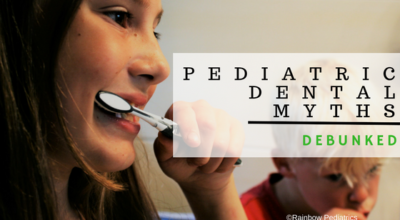Pediatric Dental Myths, Debunked
Tooth decay is the number one chronic infectious disease affecting children in the U.S., according to the American Academy of Pediatric Dentistry (AAPD). It is a preventable disease that begins at home. If parents are lax about their child’s teeth, children may grow up thinking it is less of a priority. There are many misnomers when it comes to pediatric dental care. In this week’s blog, we debunk some of the more common.
 Myth: My child doesn’t have any teeth yet, so there is no reason to brush.
Myth: My child doesn’t have any teeth yet, so there is no reason to brush.
Truth: As soon as a baby’s first teeth emerge, brushing is necessary to prevent decay. Brush their gums and teeth with a fluoride toothpaste at least once daily with a small, soft-bristled toothbrush to fit in their tiny mouths.
Myth: My child does not need to see a pediatric dentist until they have teeth.
Truth: The AAPD recommends that children be seen for their first dental examination by their first birthday or soon after their first tooth appears to prevent dental problems.
Myth: My child’s baby tooth has a cavity, but since it is a baby tooth I can ignore it.
Truth: Even though a baby tooth is temporary, it is crucial to get the cavity treated. If the tooth is left untreated, it will cause your child pain, can impair speech, and could potentially damage the permanent tooth that is developing or cause it to come in crooked. The baby tooth is holding a place for its permanent replacement. This place must be kept as healthy as possible.
Myth: Fluoride is dangerous to my child, and I should choose toothpaste that is fluoride-free.
Truth: Fluoride is very helpful in preventing cavities, especially in children. Depending on your water source, it may or may not be fluoridated. You can find out by clicking here. Even if your water is fluoridated, your child may not be getting enough fluoride from it. Drinking bottled water can dramatically impact their fluoride level. Your child’s dentist can determine if their fluoride level is adequate. Fluoride supplements and using toothpaste with fluoride added can help improve this deficiency.
Myth: If a tooth is knocked out, put it in milk.
Truth: This is not a myth! If a child (or adult) knocks out their tooth, remain calm and handle the tooth by the crown, not the root. Try inserting it back in their mouth and biting down to hold in place. If this isn’t possible or the child is too young to do this, put the tooth in milk and take the child (and tooth) immediately to the dentist.
Myth: Dental sealants are a waste of money and unnecessary.
Truth: Dental sealants provide a barrier between food and the tiny crevasses in the teeth where it can get trapped and cause cavities. The treatment protects for years and is well worth it, especially in teeth with deep ridges or pits. Most insurances cover the cost of sealants, so it is wise to take advantage of this treatment.
Myth: Babies and small children should use a special toothpaste that is fluoride-free.
Truth: In the past, it was believed that babies and children under two should use fluoride-free toothpaste. Experts now agree that children should use a small smear of fluoride toothpaste from the start to help protect their teeth from decay. Toothpaste without fluoride does not provide any protection against tooth decay and should not be used. Encourage young children to spit out the toothpaste when brushing.
Your child’s pediatric dental health is essential to the pediatric team at Rainbow Pediatrics. If you have questions and would like to schedule an appointment, call (910) 486-5437 or visit us online by clicking here.







